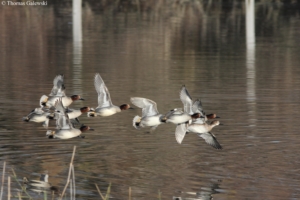1. THE Camargue
The Camargue covers 130,000 hectares of the Rhone Delta. It is the largest wetland in France, and plays a major role in providing nesting, migrating, and wintering sites for waterbirds. It is recognised as a site of international importance for the wintering and conservation of at least 18 species of waterbirds, including seven duck species and the Common Coot. Anatidae (ducks, geese, and swans) use the entire mosaic of habitats (rice fields, salt flats, natural habitats, and hunting marshes) that make up the Camargue. Their numbers and distribution depend largely on the activities carried out in these habitats, which may involve agriculture, tourism, hunting, fishing, and environmental protection.
a. Aerial counts
The first aerial counts of Anatidae wintering in the Camargue were initiated by L. Hoffmann and J. Penot in 1955, with the aim of analysing long-term demographic trends. These counts were carried out by Alain Tamisier, a researcher at the CNRS, from 1964 to 2002, based on a standardised protocol.[1] Michel Gauthier-Clerc, a research scientist at the Tour du Valat, carried out the monitoring from 2004 to 2013. Since January 2014, the surveys have been conducted by Jean-Baptiste Mouronval, who is currently a project manager at the federation for the protection and management of the Gard Camargue in the department of Gard (SMCG). The counts are co-funded by the French Biodiversity Office, the Tour du Valat Foundation, and the SMCG.
Although three scientists have been in charge successively over the past fifty years, the techniques and counting methods have remained basically the same: once a month, from September to March, a light aircraft flies over the marshes and bodies of water (currently more than 180 units), at a low altitude (80 to 100m) and at a speed of about 180 km/h. Birds are identified and the number of each species is estimated instantly ‘by eye’, usually without the use of optical or photographic equipment. The raw data is entered in a voice recorder and collated after the plane lands. The overflight of the Camargue lasts approximately 5 1/2 hours, not including refuelling time.
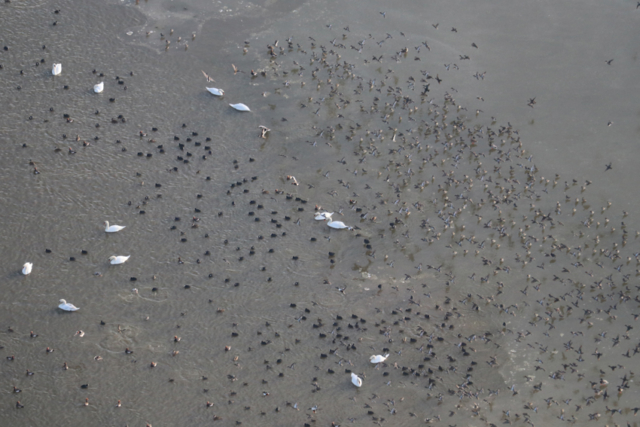
b. What is the purpose of aerial counts?
In general, avifauna counts are used to measure the conservation status of species, for example in the context of implementing the African-Eurasian Waterbird Agreement (AEWA [1]) or evaluating the implementation of the European Birds Directive. The counts are also used to identify and preserve areas that are important for waterbird conservation. The purpose of the aerial counts is therefore not to obtain precise or comprehensive figures, but to compile an index always based on the same method that can be compared by year and month in order to reliably identify the long-term trends.
2. Inventory of wintering anatidae
a. Trends
According to the aerial counts (Figure 1) over the last 20 years, the total number of huntable Anatidae in the Camargue has returned to the same level as in the 1980s and 1990s, after an increase in the 2000s. The effects stemming from changing the scientist conducting the counts in 2004 and 2013 are currently being assessed.
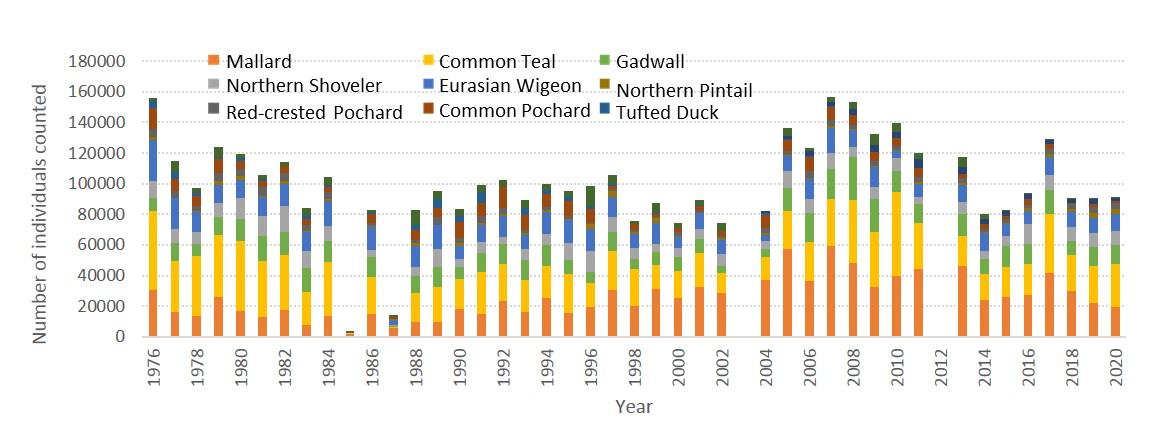
In recent years:
- The Camargue has experienced a sharp decrease in diving ducks (Common Pochard and Tufted Duck) leading to their almost complete disappearance from the area. The reasons lie mainly outside the Camargue and concern the breeding areas: predation by mammals, intensification or abandonment of fish farms, reduction of wetlands used for the extraction of raw materials in Siberia for the Pochard,[2] milder winters and currently abundant food resources in alpine lakes in the form of zebra mussels (an invasive alien species) for the Tufted Duck.
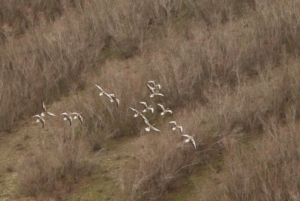
Greylag geese seen from the sky © J. Jalbert - After a rapid colonisation phase in the early 2000s, the Greylag Goose is decreasing in the Camargue (Figure 2), whereas their number appears to be stable at their breeding grounds in Central Europe. Is it because hunters are specialising in this species leading to an increase in hunting pressure, or has there been a transient wave of the Greylag Goose in the Camargue due to a greater preference for wintering sites that are closer to its breeding grounds? Studies are being conducted to respond to this question.
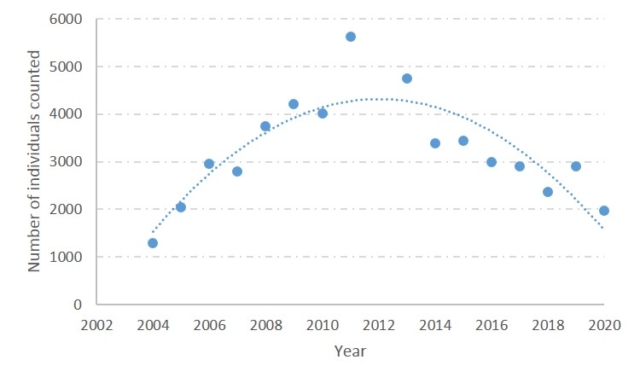
- Herbivorous Anatidae are generally increasing in France (see National Synthesis 2019; [2][3]) and also in the Camargue, especially the Mute Swan, which likes the rich seagrass beds in the freshwater wetlands.
- The Teal population has decreased compared to the 2010s, but remains about the same as in the 1980s and 1990s.
- The Mallard population has decreased since the early 2000s. An analysis of recovered Mallard rings shows that the current wintering population is made up of resident birds (including released birds) and short-distance migrants. The Camargue receives fewer and fewer migrants birds from Russia and Scandinavia, because they are now wintering further north.[4]
- The populations of the Red-crested Pochard, Gadwall, and Eurasian Wigeon are stable, although a decrease in the numbers of Eurasian Wigeon has been observed elsewhere in Europe.
- Last, more and more Northern Shoveler and Pintail have been stopping over in the Camargue, especially over the past decade.
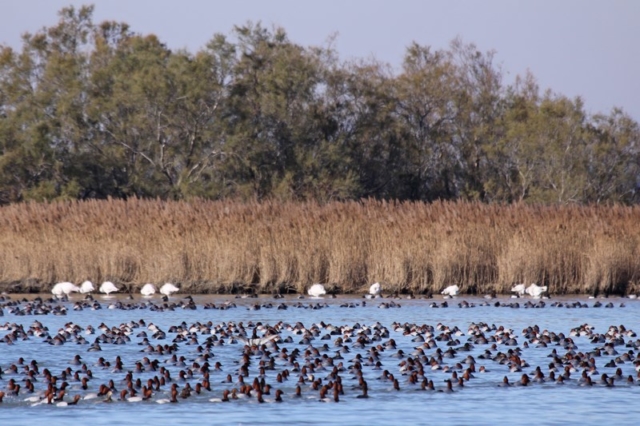
The number of birds bagged is decreasing throughout the Camargue: 80,000 ducks were harvested in the 2000s, compared to about 175,000 in the 1970s, although the data show statistical uncertainty. There are various reasons for this drop: a decrease in hunting activity due to the shorter hunting season (197 days in 1980 compared to 160 days today) and a smaller number of hunters, recent mild winters (lack of cold weather) and the abundance of food connected, in particular, to the grain hunters leave for ducks and marsh management practices, which explain why the ducks move around less, or later in the evening, thus escaping hunting pressure.
b. Perspectives in the context of climate change
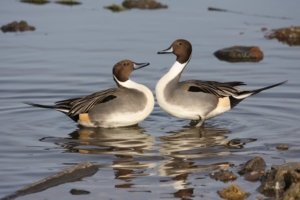
The effects of global warming have been observed in the Camargue, particularly with higher temperatures and lower precipitation in August and September. Many more migrating ducks are expected to remain in northern Europe and no longer come down to winter in such large numbers in the Camargue. This shift has already occurred with the Common Teal, whose wintering numbers on the lakes in the former Champagne region has sharply increased in recent years. Conversely, the observed increase in wintering numbers of Pintail or Northern Shoveler in the Camargue could be due to the northward movement of birds that have previously wintered in Africa. In the near future, the reduced flow of the Rhone River will reduced freshwater resources, causing saline wedge intrusion and a more frequent inflow of sea water. The Delta is expected to become increasingly saline, which will probably not be favourable for the feeding of ducks.
3. ConclusionS
The population decrease of some species of monitored Anatidae is commonly found throughout France, and even Europe, and is attributable to climatic causes or wide-scale changes in human activities. However, bird distribution throughout the Delta has also changed significantly, due to changes in the legal status of some of the sites (creation of nature reserves), and changes in agricultural and water management practices. While some may feel that there is a decrease in the bird population in the marshes they visit, others believe they are seeing an increase in numbers. In fact, the distribution of wintering ducks has fluctuated greatly between the east and west of the Camargue over the past 20 years. Detailed studies of the evolution of this intra-Camargue distribution are underway within David Vallecillo [3]‘s thesis research.
The Anatidae ultimately make up only a part of all waterbirds, which include countless other species, many of which nest in the Camargue in springtime (herons, spoonbills, gulls, shorebirds, and others). All of these waterbirds make use of both protected and exploited areas (hunting marshes, salt marshes, rice fields). This complementary site management undoubtedly explains why most waterbird species maintain good population numbers throughout the year, unlike other species such as birds living in agricultural habitats, which are decreasing.[5]
Contact : Jocelyn Champagnon, Research Scientist (e-mail [4])
References
- Tamisier A, Dehorter O. Camargue, canards et foulques. Centre Ornithologique du Gard; 1999.
- Folliot B. Dynamique des espèces exploitées : le cas du Fuligule milouin (Aythya ferina) dans le Paléarctique. PhD thesis, Université de Montpellier. 2018.
- Gaudard C, Quaintenne G, Deceuninck B, Ward A, Dronneau C, Dalloyau S. Synthèse des dénombrements d’anatidés et de foulques hivernant en France à la mi-janvier 2016. Rochefort: WI, LPO, DEB;
- Guillemain M, Champagnon J, Massez G, Pernollet CA, George T, Momerency A, et al. Becoming more sedentary? Changes in recovery positions of Mallard Anas platyrhynchos ringed in the Camargue, France, over the last 50 years. Wildfowl. 2015;65: 51–63.
- Galewski T, Devictor V. When Common Birds Became Rare: Historical Records Shed Light on Long-Term Responses of Bird Communities to Global Change in the Largest Wetland of France. PLOS ONE. 2016;11: e0165542. doi:10.1371/journal.pone.0165542 [5]
